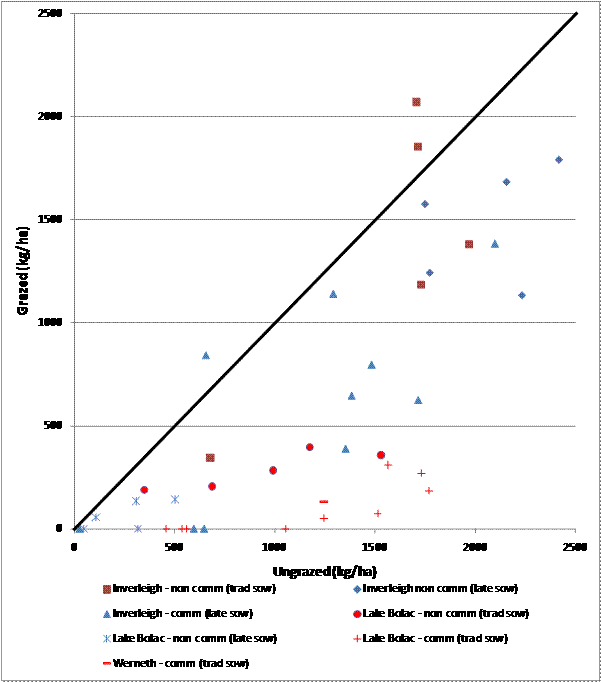Does grazing canola have a fit in the high rainfall zone?
| Date: 09 Feb 2011

Results
Seasonal conditions
2010 provided an opportunity to test the tolerance of canola to grazing under severe growing conditions. Three of the five sites (at Lake Bolac and Werneth) were severely waterlogged at grazing. Two trials at Inverleigh experienced much less severe conditions. At all sites the canola plants were grazed briefly (approximately 5 days each) but severely, removing all the leaves and some of the stem. While grazing would not be recommended under these waterlogged conditions or degree of leaf removal, defoliation and trampling by the animals enabled the worse case results to be measured.
The severity of the conditions were reflected in the lower yields even from the non grazed canola at Lake Bolac and Werneth compared to the less challenging conditions at Inverleigh (Table 1). This was especially evident for the later sowing date (Table 2).
Table 1. Grain yield (t/ha) at Inverleigh (favourable conditions) and Lake Bolac (challenging conditions) sown in mid May
|
Variety
|
Inverleigh
(sown May 15)
|
Lake Bolac
(sown May 20)
|
|
Hyola 571 (CF)
|
1.97
|
1.17
|
|
46Y78 (CF)
|
1.76
|
1.53
|
|
46Y20 (RR)
|
1.73
|
0.99
|
|
Jardee (TT)
|
1.71
|
0.69
|
|
Marlin (TT)
|
0.68
|
0.35
|
|
Variety
|
Inverleigh
(sown June 15)
|
Lake Bolac
(sown June 18)
|
|
46Y78 (CF)
|
2.42
|
0.31
|
|
Jardee (TT)
|
2.23
|
0.11
|
|
Marlin (TT)
|
2.16
|
0.05
|
|
Hyola 571 (CF)
|
1.77
|
0.32
|
|
46Y20 (RR)
|
1.75
|
0.50
|
|
Treatment
|
Inverleigh 1
(sown May 15)
|
Inverleigh 1
(sown June 15)
|
Inverleigh 2
(sown June 15)
|
|
Ungrazed
|
1.94
|
2.05
|
1.12
|
|
Grazed
|
1.62
|
1.74
|
0.58
|
|
LSD p<0.05
|
Not significant
|
0.30
|
|
|
Treatment
|
Lake Bolac 1
(sown May 15)
|
Lake Bolac 1
(sown June 15)
|
Lake Bolac 2
(sown May 20)
|
|
Ungrazed
|
1.02
|
0.27
|
1.16
|
|
Grazed
|
0.26
|
0.10
|
0.10
|
|
LSD p<0.05
|
0.18
|
0.27
|
|
Figure 1. Comparison of grain yield for grazed and ungrazed canola at Inverleigh, Lake Bolac and Werneth (traditional and late sowing times)
Three varieties were able to recover from grazing and still produce a ‘commercial’ grain yield equivalent to no grazing. These were 46Y78, Jardee and 46Y20. Variety 46Y20 and Hyola 502 also produced equivalent grain yield to no grazing, but yields were lower than ideal. However the late sowing (mid June) may explain the lower yield. These results were all achieved at the Inverleigh site, where water logging conditions were less severe. At the more severely waterlogged sites, a significant loss in grain yield was measured due to grazing.
To put these results into perspective, the experimental lines also were compromised by the severe waterlogged conditions (Figure 2).
Figure 2. Comparison of grain yield for grazed and ungrazed experimental canola lines at Inverleigh and Lake Bolac (traditional and late sowing times)

DM available for grazing
There was large variability in the dry matter produced by the different canola varieties (Figure 3). The hybrid varieties, sown in mid May were able to produce valuable quantities of drymatter for grazing. As expected late sowing reduced the amount of drymatter available.
Figure 3. Drymatter available for grazing at Inverleigh and Lake Bolac (traditional and late sowing times)

|
Variety
|
Ungrazed
(pl/m2)
|
Grazed
(pl/m2)
|
|
Marlin (TT)
|
50
|
7
|
|
Lightning (TT)
|
68
|
6
|
|
Jardee (TT)
|
42
|
18
|
|
Tumby (TT)
|
56
|
5
|
|
46Y83 (CF)
|
75
|
10
|
|
46Y78 (CF)
|
93
|
15
|
|
Hyola 571(CF)
|
67
|
20
|
|
46Y20 (RR)
|
76
|
27
|
|
Hyola 502 (RR)
|
23
|
22
|
Figure 4. Drymatter available for grazing and impact on grain yield by grazing (Inverleigh, Werneth and Lake Bolac, traditional and late sowing times)

- Late sown canola
- Water logged conditions at grazing or in the post grazing recovery period
- Complete defoliation of the plants
- Incorrect paddock selection - Low nutrient availability or poor seed bed preparation.
- Incorrect variety selection that have poor vigour eg non hybrid TT’s.
- High weed populations
Was this page helpful?
YOUR FEEDBACK
